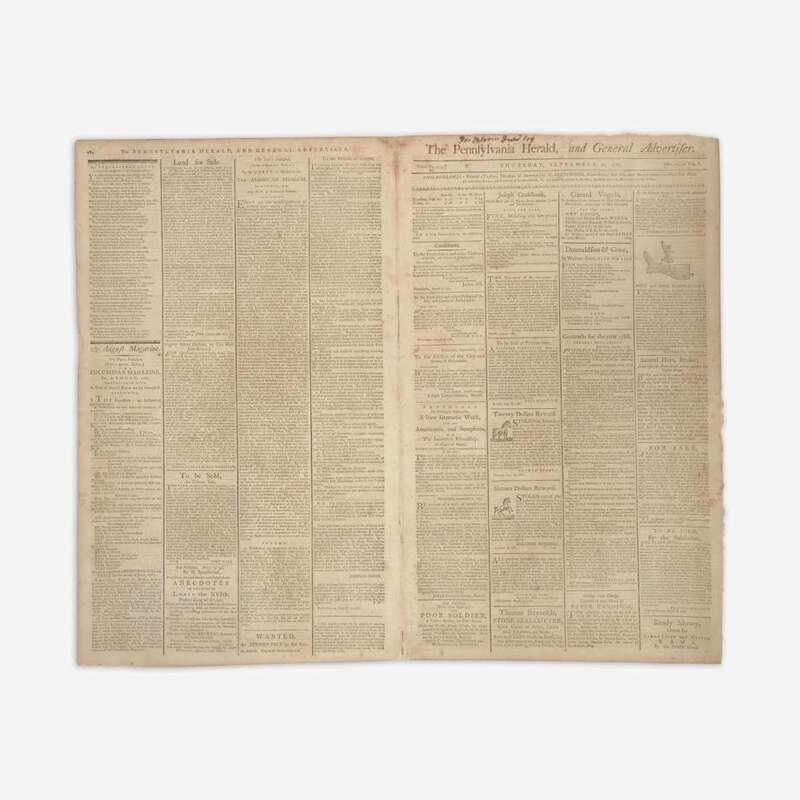Condition Report
Contact Information
Lot 16
Lot Description
United States Constitution: Rare Second Day Publication
“WE, the People of the United States, in order to form a more perfect union, establish justice, insure domestic tranquility, provide for the common defence, promote the general welfare, and secure the blessings of liberty to ourselves and our posterity, do ordain and establish this constitution for the United States of America.”
"It is obviously impracticable in the federal government of these states, to secure all rights of independent sovereignty to each, and yet provide for the interest and safety of all: Individuals entering into society, must give up a share of liberty to preserve the rest...It is at all times difficult to draw with precision the line between those rights which must be surrendered, and those which may be reserved...the several states as to their situation, extent, habits, and particular interests."
Philadelphia: W(illiam). Spotswood, Thursday, September 20, 1787. Total No. 279; No. 71, of Vol. V. Printed bifolium newspaper, 19 x 11 3/4 in. (483 x 298 mm). (iv) pp. Edited by Alexander J. Dallas. Inscribed, " Jos. Bloomfield Esq.,” likely New Jersey Attorney General Joseph Bloomfield (1753-1823), who later served as the state’s governor. Creasing from old folds; scattered minor spotting. Rapport, Printing the Constitution, p. 83
A very rare newspaper printing of the United States Constitution, published the day following its first-ever newspaper appearance in the United States. The Pennsylvania Herald was a tri-weekly newspaper, and although it did not publish on Wednesday, September 19, when five other Philadelphia newspapers first published the text of the new Constitution for the public (all of which have competing claims as the first public printing), it is the only newspaper in the United States to print the historic document on September 20. The Constitution would make its first newspaper appearance outside of Philadelphia the day following this printing, on September 21, in New York. Within 20 days, at least 55 of the approximately 80 newspapers of the period had printed it. Thanks to a free press, with the text of the Constitution before the people, the great debate on its ratification would begin. Ratification by the original 13 states was completed in 1790, and culminated in 1791 by the adoption of the Bill of Rights.
This is the only September 1787 newspaper printing of the Constitution that features the entirety of the document's text on a single page. It appears on the second page, and is followed by George Washington’s two Resolutions to the Confederation Congress. The first resolved that the proposed United States Constitution be “laid before the “United States in Congress assembled,” meeting in New York under the Articles of Confederation, and provided a succinct plan for it to be sent by them to the states for ratification, and once ratified, implementing the new Federal government by electing representatives, convening Congress, and electing the first president. The second was a transmittal letter to the Confederation Congress, that acknowledged that every state would disagree with certain points of the document, but that compromise was necessary to secure the greater interests of all, and that they should accept it in its entirety, "As in all our deliberations on this subject we kept steadily in our view, that which appears to us the greatest interest of every true American, the consolidation of our Union, in which is involved our prosperity, felicity, safety, perhaps our national existence."
The Constitution was approved and signed by the Convention in Philadelphia on Monday, September 17, 1787, after four months of secret and contentious debate. Once adopted, the document was then immediately sent to Dunlap & Claypoole for printing, and by the next morning, Tuesday, September 18, up to 500 copies were printed for distribution to and by the Convention's delegates. That same Tuesday, William Jackson, the Secretary to the Convention, got on a coach to New York to deliver the results to the Confederation Congress (he arrived two days later, the same day of this publication). Simultaneously, it was publicly read for the first time before the Pennsylvania General Assembly. It appeared in newspaper form for the first time the following day, September 19, in the Pennsylvania Packet.
The Pennsylvania Herald, and General Advertiser (1785-1788), was founded by Irish-born Mathew Carey (1760-1839) in January 1785 as Carey’s Pennsylvania Evening Herald. Carey had fled Dublin to avoid prosecution for his anti-British publications, arriving in Philadelphia in November 1784. Learning of his misfortunes, the Marquis de Lafayette gave him $400 to start a newspaper. By March 1785, it had become the Pennsylvania Evening Herald, and the American Monitor, with fellow Irishmen Christopher Talbot and William Spotswood as partners. Carey began attending Pennsylvania’s General Assembly in the summer of 1785, taking down the debates and votes in shorthand. Although newspapers in England had begun to do so, it was novel in the United States, and the circulation of the Herald grew dramatically. At the end of May 1786, the title was changed to The Pennsylvania Herald, and General Advertiser. In February 1787, the partnership dissolved, and Spotswood continued publishing the paper alone. In February 1788, when he retired, Carey again became the publisher. The Herald was typically published semi-weekly on Wednesdays and Saturdays, but from September 11 to October 6, it was published tri-weekly, on Tuesdays, Thursdays, and Saturdays.
Very Rare. First and second day newspaper publications of the Constitution seldom come to market, and we are not aware of any other examples of this edition in private hands. Only six institutions list runs of The Pennsylvania Herald, and General Advertiser that presumably include this issue, including the American Antiquarian Society, Historical Society of Pennsylvania, Library of Congress, New York Public Library Research Library, Western Reserve Historical Society, and the New-York Historical Society. Of those six, only the New-York Historical Society's collection is confirmed to have this issue.





